|
Here are detailed drawings for
the Douglas A-20 Boston / Havoc Bomber that I electronically scanned from my purchased
copy of the November 1970 American Aircraft Modeler magazine. Per
Wikipedia: "The
Douglas A-20 Havoc (company designation DB-7) is an American medium bomber,
attack aircraft, night intruder, night fighter, and reconnaissance aircraft of
World War II. Designed to meet an Army Air Corps requirement for a bomber, it
was ordered by France for their air force before the USAAC decided it would also
meet their requirements." Because the drawings
span two pages (click image for larger versions), you will need to adjust the size and alignment a bit to
get halves to line up properly. From there, with some extra effort you should be
able to create plans for a model if
plans can no longer be purchased or you just enjoy drawing plans (I do). Line
drawings for this fine model were created by
Mr. Björn Karlström.
Douglas A-20 saw widespread service in many roles throughout World
War II
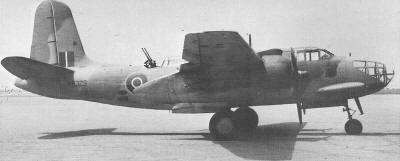 Don Berliner Don Berliner
Photos by Howard Levy
An RAF Boston III in Egypt in 1943. Photo fortunately reveals the twin swivel-mounted
guns in rear cockpit, gun pod on side of nose.
MORE THAN SEVEN THOUSAND were built, yet it doesn't stand out as one of the major
types in the history of military aviation. Produced as both a bomber and a fighter,
it entered service before Pearl Harbor and remained operational to the end of the
Second World War. Yet few, aside from those who flew the Douglas A-20 or one of
its many variations, remember the type as anything more than a familiar light twin
that did many jobs well, but never did anything really spectacular.
Perhaps because of its origins the Havoc or Boston, or whatever you want to call
it, is something of an under-appreciated airplane. It began as the Douglas Model
7 A, a company project intended to be the U.S. Army Air Corps' first twin-engined
attack bomber. The original 7 A never was completed, but the 7B flew for the first
time late in 1938, at more than 300 mph---quite a speed for bombers in those days.
It was not only fast, but it also was unusually well-armed, with eight .30-cal.
machine guns in the B version and an additional four in the solid nose of the A
version.
While the airplane looked highly promising to the USAAC, the first orders came
from the French who contracted for 380, highly modified in light of what had been
learned in the Spanish Civil War. Known as the DB-7, fewer than half of those ordered
were delivered to France before that country fell to the Germans, and hardly any
of those planes got into action. By a variety of routes, a large number of them
came to the Royal Air Force, where they were pressed into service as trainers, bombers
and fighters, including some of the first radar-equipped night fighters.
 Because of the desperate need for night fighters
to hold off the German He-Ills, Ju-88s and Do-217s, the British tried some novel
ideas, including trailing a bomb on a 2000-foot cable behind the Pandora version
of the Havoc I, in hopes of dragging it into low-flying- bombers. A more practical
idea was the Turbinlite, a monster searchlight grafted onto the nose of a Havoc
or Boston, in place of the far more graceful solid or clear nose. The intention
was to' light up enemy aircraft so that they could then be shot down by single-engined
fighters. Before the system was fully developed-if, indeed, it ever could have been-airborne
intercept radar came into being and the bulky light was replaced by strange collections
of antennas. Because of the desperate need for night fighters
to hold off the German He-Ills, Ju-88s and Do-217s, the British tried some novel
ideas, including trailing a bomb on a 2000-foot cable behind the Pandora version
of the Havoc I, in hopes of dragging it into low-flying- bombers. A more practical
idea was the Turbinlite, a monster searchlight grafted onto the nose of a Havoc
or Boston, in place of the far more graceful solid or clear nose. The intention
was to' light up enemy aircraft so that they could then be shot down by single-engined
fighters. Before the system was fully developed-if, indeed, it ever could have been-airborne
intercept radar came into being and the bulky light was replaced by strange collections
of antennas.
All the while the British were enthusiastically using the trim Douglas fighter/bomber,
the U.S. was moving ahead with its plans. The first A-20A's were ordered in July
1939, and deliveries commenced in 1940. By 1941, as the war in Europe gained intensity
and U.S. entry neared, orders for the machine poured in from not only the USAAF
and the RAF, but also from European governments-in-exile who were fighting from
British bases.
As the airplane saw more action, it was continually modified. Armament was increased,
as was the bomb load. To handle the rapidly increasing weight, the original Pratt &
Whitney R-1830 Twin Wasp engines of some 1100 hp. were replaced by Wright R-2600
Cyclones of 1600 hp. Early problems with directional stability were corrected by
enlarging the vertical tail, thus changing its original highly tapered form to the
more familiar squared-off shape.
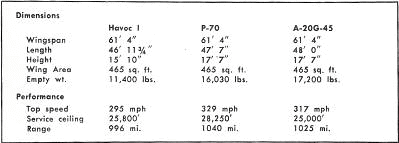 By 1942, substantial numbers
of A-20's were being sent to the USSR, some of them for the Soviet Navy's use as
torpedo bombers. In all, nearly 3000 went to the airplane-hungry Russians. Most
of these planes were A-20G's with heavy batteries of guns in the nose, which made
them highly effective against tanks and other hefty ground targets. By 1942, substantial numbers
of A-20's were being sent to the USSR, some of them for the Soviet Navy's use as
torpedo bombers. In all, nearly 3000 went to the airplane-hungry Russians. Most
of these planes were A-20G's with heavy batteries of guns in the nose, which made
them highly effective against tanks and other hefty ground targets.
The RAF's successful use of modified bombers for night-fighting purposes did
not escape the notice of the USAAF, and about 270 A-20's were converted into what
was then the Army's heaviest fighter plane, the P-70. The first of these carried
four 20-mm cannon in a special package under the fuselage. The P-70 was used primarily
to train pilots who eventually were assigned to the North- (the rest will be scanned
on request)
- A-20 - first production version for USAAF; Wright R-2600-7 engines; 59 converted
to P-70, 1 to XF-3, 2 to YF-3.
- A-20A - 143 built with R-2600-3 engines.
- XA-20B - 1 A-20A tested with three power turrets.
- A-20B - 999 built with Wright R-2600-11 engines.
- A-20C - 948 similar to RAF Boston III, Wright R-2600-23 engines.
- A-200 - never built; would have had R-2600-7 engines.
- A-20E - 17 A-20A modified with Wright R-2600-11 engines.
- XA-20F - 1 A-20A, one 37 mm cannon, two power turrets.
- A-20G - 2850 built with Wright R-2600-23 engines.
- A-20H - 412 as A-20G with 1700-hp Wright R-2600-29 engines.
- A-20J - 450 built as A-20G with bomber nose; 169 to RAF as Boston IV.
- A-20K - 413 built as A-20H with bomber nose.
- BD-1 - several A-20A built for U.S. Navy.
- BD-2 - 8 A-20B built for U.S. Navy.
- OB-7 - original design of series, ordered by French, diverted to RAF as Boston
I and II. Pratt & Whitney R-1830 Twin Wasp engines. OB-7A - 100 for France become
RAF Havoc II. Wright R-2600 engines.
- OB-7B - 300 for RAF as Boston III.
- OB-7C - 48 similar 10 Boston III for Dutch AF in exile.
- DB-131 - 1 DB-7 tested by France with twin rudders.
- XF-3 - photo version of A-20.
|
- YF-3 - 2 A-20 converted to photo recon.
- F-3A - 46 A-20J and A-20K converted to photo recon.
- 0-53 - 1489 photo recon versions of A-20B cancelled.
- XP-70 - A-20 modified to fighter with four 20 mm cannon in nose.
- P-70 - 59 A-20 modified as fighters.
- P-70A-1 - 39 A-20C modified as fighters.
- P-70A-2 - 65 A-20G modified as fighters.
- P-70B-1 - 1 A-20G modified as fighter.
- P-70B-2 - 105 A-20G and A-20J modified as fighters.
- Boston I - ex-French DB-7's to RAF for training.
- Boston II - ex-French DB-7's to RAF as bomber.
- Boston III - 300 ex-DB-7B's to RAF.
- Boston III Tutbinlite - three Boston III with 2.7 billion candlepower light
in nose.
- Boston IIIA - Boston III built by Boeing for RAF.
- Boston IV-169 A-20J for RAF.
- Boston V-90 A-20K for RAF.
- Havoc I - ex-French DB-7's 10 RAF as fighter.
- Havoc 1 Turbinlite - 31 Havoc I, 2.7 billion candlepower light. Havoc II - ex-French
DB-7A's to RAF.
- Havoc II Turbinlite - 39 Havoc II modified with light in nose.
- Havoc III - became Havoc I "Pandora" version; 20 modified.
- Havoc IV-become Havoc I (Intruder).
- Douglas 7A - prototype, fighter nose, P&W R-1830 engines. Douglas 7B - prototype,
bomber nose, P&W R-1830 engines.
|
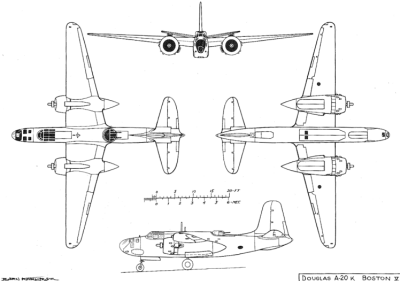
Douglas A-20 Boston / Havoc Bomber
Article & Plans <click for larger version>
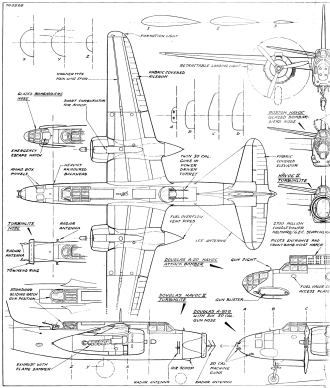 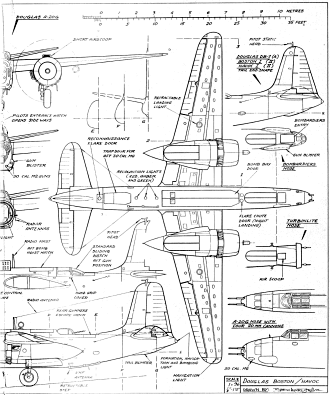
Douglas A-20 Boston / Havoc Bomber
Article & Plans <click for larger version>
Notice:
The AMA Plans Service offers a
full-size version of many of the plans show here at a very reasonable cost. They
will scale the plans any size for you. It is always best to buy printed plans because
my scanner versions often have distortions that can cause parts to fit poorly. Purchasing
plans also help to support the operation of the
Academy of Model Aeronautics - the #1
advocate for model aviation throughout the world. If the AMA no longer has this
plan on file, I will be glad to send you my higher resolution version.
Try my Scale Calculator for
Model Airplane Plans.
Björn Karlström Drawings:
Posted August 14, 2021
|



